ASRock Rack has a history of making some unique motherboards. The ASRock Rack GENOAD8UD-2T/X550 firmly fits into that category. If you are looking for a motherboard that fits an AMD EPYC Genoa in a smaller-than-EATX form factor (which is what most options are these days) then this might be the motherboard for you. At the same time, there are trade-offs being made that we found when building around this motherboard. Let us get to the hardware.
Just as a quick note, we are working on a build piece with this motherboard so expect to see it again soon. We wanted to get the motherboard review out first, then show an application of the motherboard.
ASRock Rack GENOAD8UD-2T/X550 Hardware Overview
Let us start with the first unique feature: the form factor. This is not a 9.6″ x 9.6″ mATX form factor or a 12″ x 9″ ATX form factor. Instead, it is 10.4″ x 10.5″. Even with a non-standard size, even finding room for the motherboard standoff mounting points appears as though it was more challenging for ASRock Rack. That non-standard chassis also meant that the first chassis we tried to build this motherboard into did not fit.
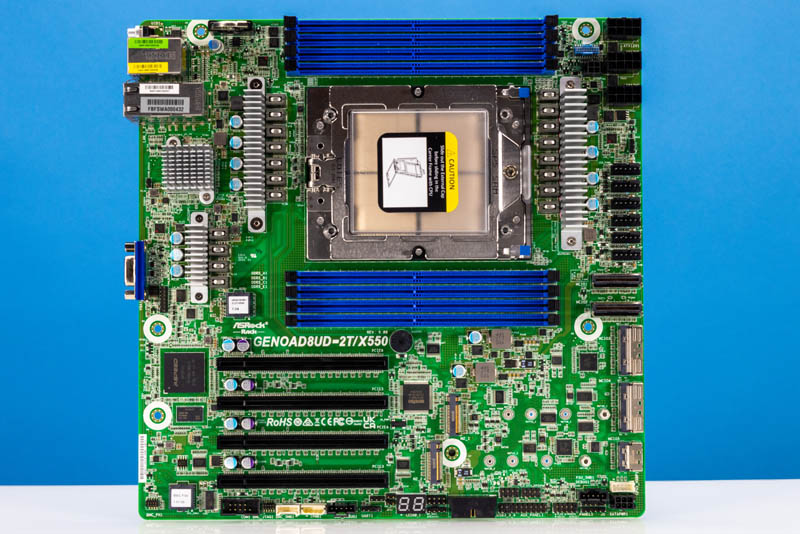
The second trade-off is the CPU and memory configuration. ASRock Rack supports Socket SP5 for the AMD EPYC 9004 Genoa processors. In our recent ASRock Rack 1U4LW-B650/2L2T AMD Ryzen server review we saw a motherboard that was larger than this one housing only sixteen cores. This ASRock Rack platform can house up to 96 today, and we expect 128 with Bergamo later this year. That is the point of the platform, to densely populate cores into smaller form factors. A key trade-off to make this work is that instead of a full set of 12x DDR5 RDIMM slots, we get only 8x. There is just not enough room on the motherboard to fit more than this.
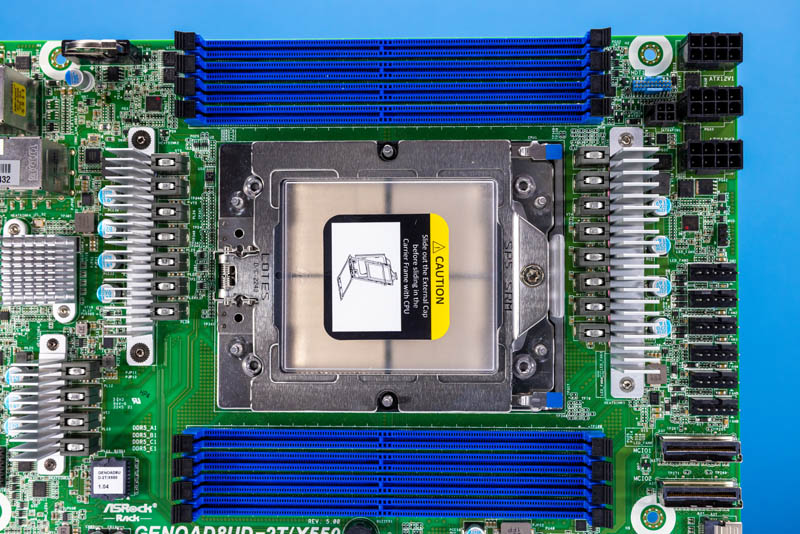
On the right edge of the motherboard, we can see six five-pin fan headers. That is a fairly good set since we expect this platform to need cooling. A third trade-off with the platform is the power situation. Given physical size constraints, the motherboard does not have a standard 24-pin power connector. Instead, it has three 12V CPU power inputs. That does mean it also supports DC input if one has a large 12V DC power source. Many power supplies do not have three 12V inputs, and one needs to use an adapter to perform normal power functions from a standard power supply’s 24-pin ATX connector.
While that may sound like a lot of trade-offs, there are some areas where this blows away a standard mATX motherboard beyond just the core counts. For example, there are four PCIe expansion slots. These are not just for show, each is a PCIe Gen5 x16 slot. That is only half of the EPYC Genoa’s PCIe Gen5 slot capacity. The Gen5 x16 slots are also the lanes from the EPYC CPU that support CXL 1.1 Type-3 devices. See Compute Express Link CXL 3.0 as our latest guide in that area. We did not get to test these slots with the CXL devices, however, we are still in the early days of devices and support so our readers should view CXL support as a bit of a forward-looking feature.
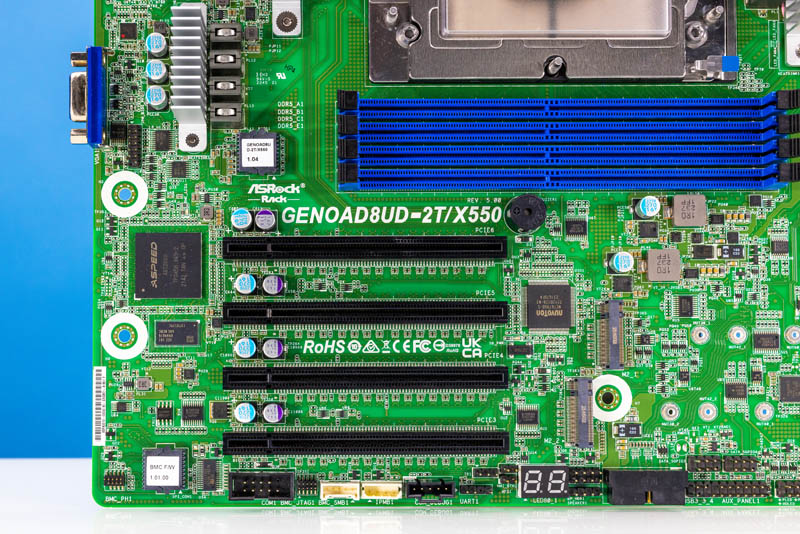
Having 64x PCIe Gen5/ CXL lanes is great, but there is a lot more. Next to these slots are two PCIe Gen4 x4 M.2 slots for boot SSDs.
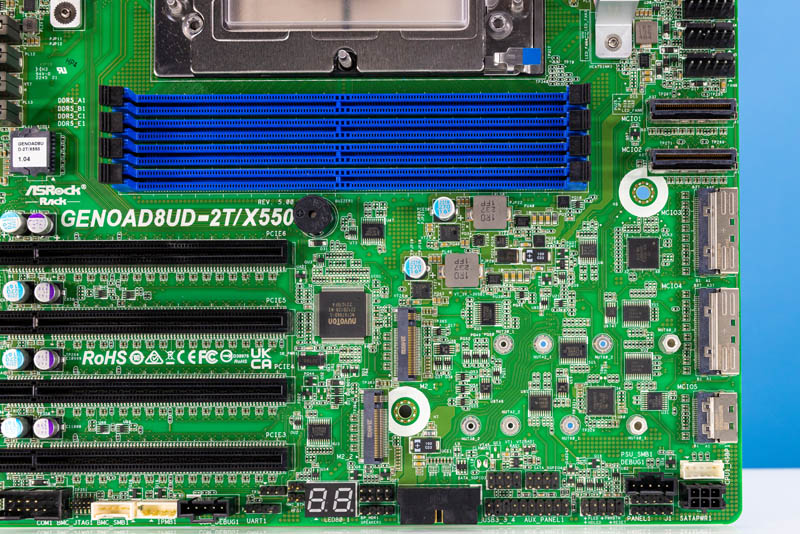
There are headers and a POST code display on the bottom edge of the motherboard, but the other big feature is on the right edge. There are a total of four PCIe Gen5 x8 MCIO connectors and one x4 MCIO. MCIO is a newer connector for the PCIe Gen5/ CXL generation, however, these are PCIe Gen5. Two of the x8 connectors can also run as 8x SATA III headers, but our sense is that it is more efficient to use a HBA to connect to lower-speed SATA devices. There are no 7-pin SATA connectors on this motherboard which feels refreshingly modern.
One nice feature is that ASRock has these MCIO connectors that are in line with the PCIe x16 slots parallel to the motherboard. It also means that if you plan to use this motherboard in a chassis there is a bit of extra chassis clearance needed to use these ports.
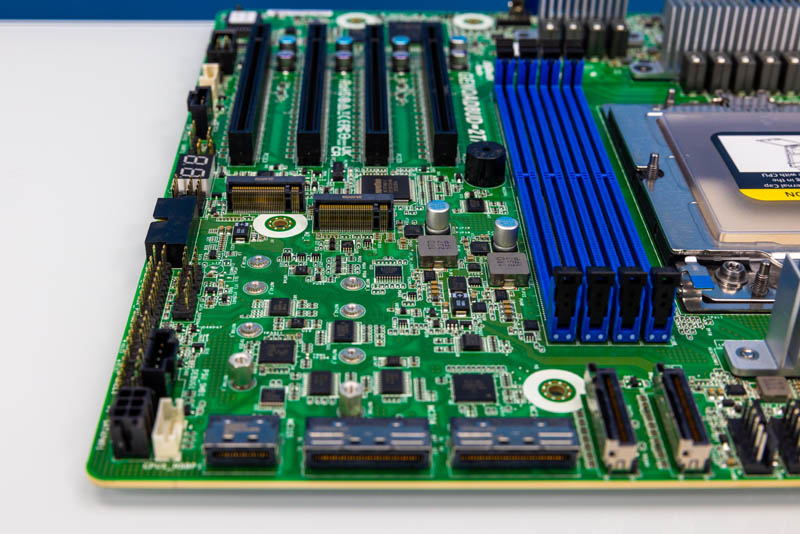
Here is a view from the other angle.
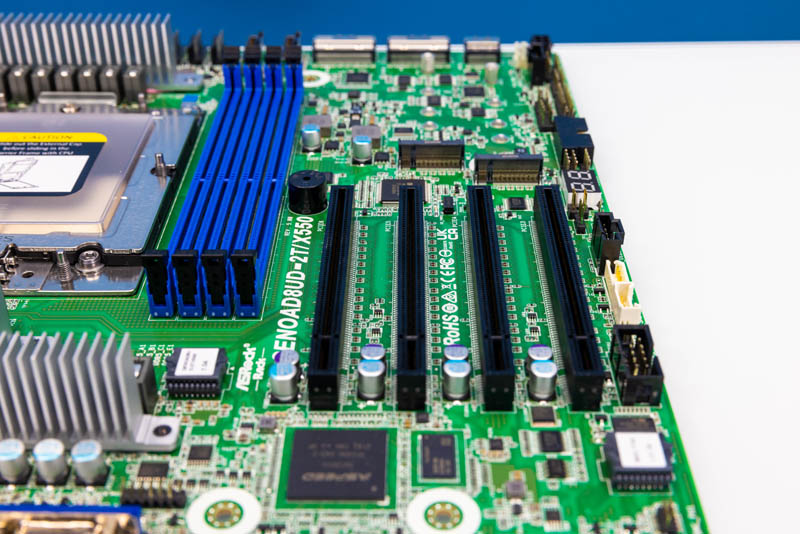
Here is a view looking at the motherboard from the standard airflow direction to give a sense of the profile and how the slots and connectors align.
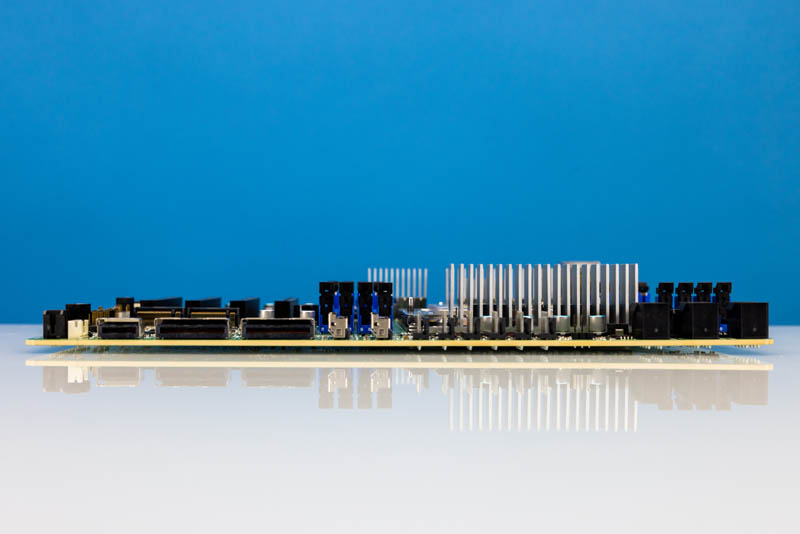
Next to the CPU we have the VRM heatsinks but also a heatsink for the Intel X550 NIC. This platform has 10Gbase-T networking. There is not a lot of space, so having at least 10GbE instead of 1GbE is welcome.
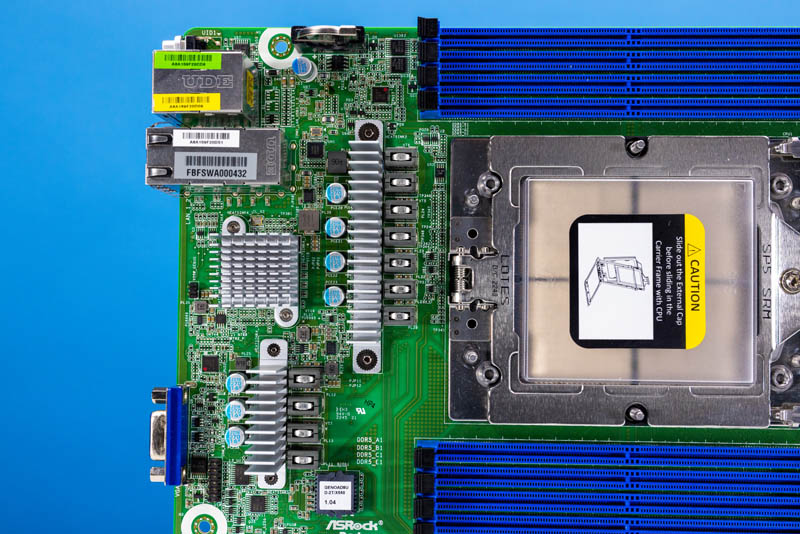
Aside from the two RJ45 10Gbase-T ports, there is not a lot else on the rear I/O side of the motherboard. A VGA port and two USB 3 ports provide local access. A management port provides out-of-band access to the platform.
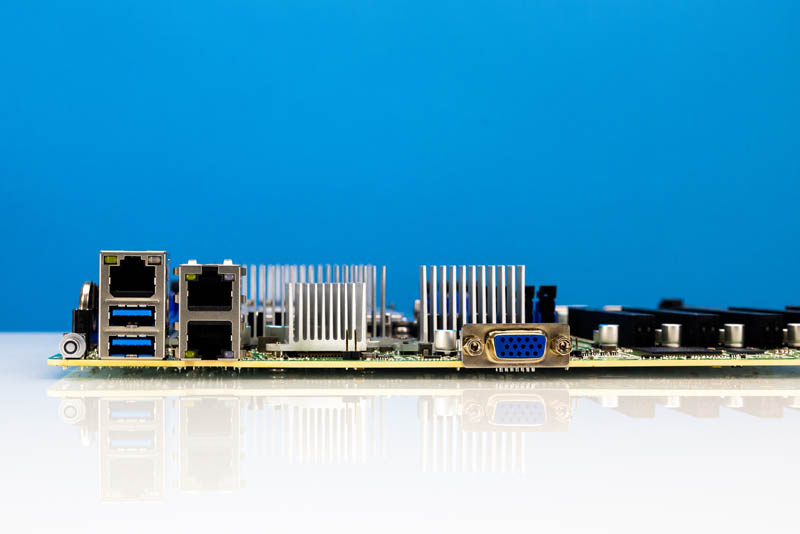
Next, let us get to the management and performance.

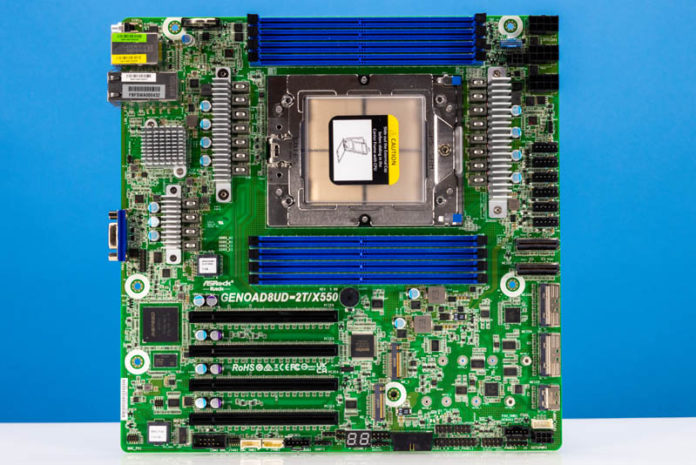



Honestly, the biggest thing holding me back from the SP5 platform is the lack of a quiet cooler like Noctua built for SP3. EK has a waterblock but that gets expensive.
I’m sure I could search it out, but does ASRock/Rack provide a chassis designed around the 10.4×10.5?
For servers, I build barebones more than try to piece together a mainboard with a psu/chassis.
I don’t have time to hunt out oddball ATX sizes…that’s what my gaming workstation is all about, hobbyist stuff. I love supermicro builds, but over the years I’ve moved to just buying the barebones if I’m “building a server” versus buying a Dell/HP/Lenovo box. And in a homelab I’m buying ebay servers on the cheap…not building new.
It’s cool to see, but I don’t think I’d get this product outside of a barebones offering from Asrack…which is perfectly fine, but I’d rather see the review of that because the backplane/chassis/psu matter just as much as the platform.
What is the idle power usage or the system used? Rome ended up around 100W, right?
Will this fit in a standard Fractal Define 7?
Now if the rest of the world would move along we could drop PCIe x16 slots altogether in favour of PCIe Gen5 x8 MCIO sockets or similar and cable the interconnect.
Just imagine how much easier to make a mobo without x16 slots. How much easier to build a platform around air flow not those darn slots. Your mini ITX board could even provide the entire suite of lanes.
Shorter traces, should even be cheaper. Oh wait, who am I kidding…
Losing 1/3 of the memory bandwidth seems an unfortunate trade-off. Could a more standard of ATX size have accommodated the extra memory slots?
I’m looking forward to the follow-up project built using this motherboard.
Just to trouble you further with product names, Toshiba uses ‘(‘ as a separator in their optocoupler part numbers. And yes, they’re unmatched. Digikey has plenty: https://www.digikey.com/short/93bt5r41 “TLX9000(TPL,F” is one such example.
@Patrick or others. What exact 24pin to 12v EPS adapter is needed if the PSU does not have 3 x 12v EPS connectors?
“Many power supplies do not have three 12V inputs, and one needs to use an adapter to perform normal power functions from a standard power supply’s 24-pin ATX connector”
Yeah, they should just provide that 24-pin ATX to 3*12V adapter with the motherboard.
What can we do with these new fancy MCIO thingies ? I tried searching a bit, but am confused…
@Vincent Legoll: They do, according to the manual. It just provides a way to activate the ATX power supply – you can use a straight 12V supply, likely with no soft-power switch (the motherboard handles power-good internally, or at least the C246 WSI does).
Why won’t the VGA port die already?
Everything about this MB is forward looking except that darn analog blue port, but it keeps showing up when there are much better digital connectors.
@Dave: this is probably due to the old generation IPMI module used.
I would have prefered SFP+ instead of RJ45 10Gbe. You can always put a RJ45 SFP+ module if you need that, whereas your 10Gb switch may only have SFP+ ports and then it becomes useless (media converter excluded for sanity’s sake)…
Does this motherboard have ATX mounting hikes or not ?
Mounting holes
@Patrick – What chassis and what power supply did you use for the build?
Please post a detailed article on the full build with a complete parts list used.
I was planning on a similar / identical build and same motherboard and stumbled upon this review, but you didn’t give any information on the build, what parts you used or what power supply, or chassis that you managed to get this to fit into. Would be helpful if you gave us more details and posted pictures of the build.
I love STH, but at least finish the build article and post it so we can see what you used.
@Patrick – Also post some pictures and a link for the “24-pin ATX to 3*12V adapter” that you used. Does ASRock provide one with the motherboard?